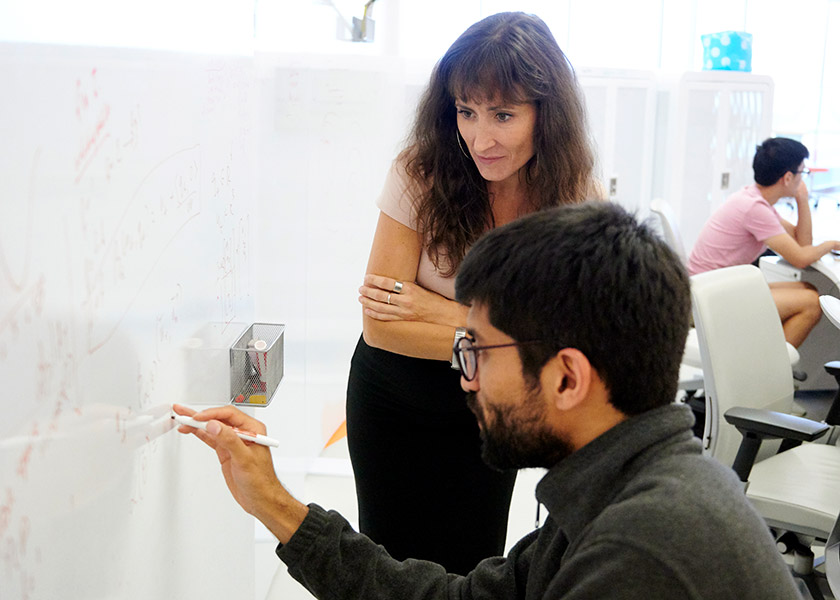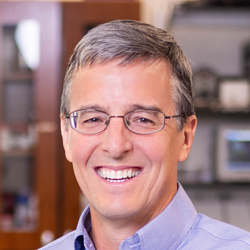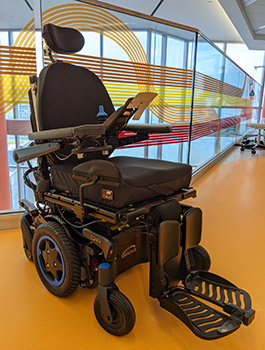Accelerating the Accessibility and Utility of Power Wheelchairs
A multidisciplinary team led by Professor Brenna Argall received a Phase 1 NSF Convergence Accelerator award
While enabling independent mobility for many people with motor impairments related to disease or injury, the power wheelchair is overly burdensome or entirely inaccessible for millions with limited movement capabilities. Those limits can deprive persons with disabilities and their caregivers of independence and engagement within the community and workforce.
To deliver tangible, transformative solutions for such societal challenges, the National Science Foundation (NSF) launched the Convergence Accelerator program in 2019 within the Directorate for Technology, Innovation and Partnerships.
A multidisciplinary partnership of academic, industry, and non-profit members including Northwestern Engineering’s Brenna Argall and John Rogers is among the 16 teams selected for NSF Convergence Accelerator Phase 1 funding for the 2022 cohort of Track H: “Enhancing Opportunities for Persons with Disabilities.”
The nine-month, $724,415 Phase 1 project titled “Mobility Independence Through Accelerated Wheelchair Intelligence” aims to accelerate the accessibility and utility of power wheelchairs by radically changing how control inputs are interpreted from movements of the human body and communicated to the wheelchair control system. Practical machine intelligence will also enhance safety and facilitate independent wheelchair operation.

“We're going to do a better job of capturing control signals from the human body so that virtually anywhere on the body that has some sort of residual movement can be used to operate the control interface for the wheelchair,” said Argall, associate professor of computer science and mechanical engineering at the McCormick School of Engineering, and associate professor of physical medicine and rehabilitation at Northwestern University’s Feinberg School of Medicine. "We’re going to interpret that data within an intelligence paradigm that's able to help users better operate the chair and perform more projective tasks, such as navigating around an obstacle.”
Argall, who heads the Assistive and Rehabilitation Robotics Laboratory (argallab) at the Shirley Ryan AbilityLab, is the principal investigator (PI) of the NSF Convergence Accelerator project. The argallab team working on the project also includes mechanical engineering PhD students Larisa Loke and Andrew Thompson; and research assistant Joel Goh, who is pursuing a bachelor’s degree in biomedical engineering and a master’s degree in computer science.
 Rogers, the Louis Simpson and Kimberly Querrey Professor of Materials Science and Engineering, Biomedical Engineering and Neurological Surgery, is a co-PI.
Rogers, the Louis Simpson and Kimberly Querrey Professor of Materials Science and Engineering, Biomedical Engineering and Neurological Surgery, is a co-PI.
Both Argall and Rogers also plan to hire Summer Research Opportunity Program (SROP) interns to assist with the project as part of an effort to broaden participation in computing.
Three fronts of research
The full-pipeline NSF Convergence Accelerator project involves three research thrusts.
Argall is the lead of the wheelchair intelligence thrust, which will build on an existing, highly successful research partnership with LUCI, an advanced wheelchair technology company that pioneered the first commercially available, sensor-based wheelchair driver assistance system.
 The argallab team will integrate a software suite framework into the LUCI platform that includes a navigation binary leased from Relay Robotics, an autonomous service robotics company, along with shared-control paradigms that the argallab previously developed to reason about how the human and the robotics autonomy share control of the machine.
The argallab team will integrate a software suite framework into the LUCI platform that includes a navigation binary leased from Relay Robotics, an autonomous service robotics company, along with shared-control paradigms that the argallab previously developed to reason about how the human and the robotics autonomy share control of the machine.
Rogers’s team will focus on developing a novel sensor interface that will conform to the body of the wheelchair user, bridging the gap in accessible wheelchair control between drivers who can operate a joystick and those who cannot.
The LUCI team, headed by CTO and co-founder Jared Dean, will lead the communication protocol thrust to develop an open-source and digital application programming interface (API) for bilateral communication between the wheelchair control system and input devices, such as the interface designed by Rogers’s group.
“If you plug an interface into the current input mechanism on power wheelchairs, there's no information from the wheelchair that comes back out to the interface. The joystick is not receiving information from the wheelchair, the wheelchair just receives information from the joystick,” said Argall, a member of Northwestern Engineering’s Center for Robotics and Biosystems. “We need the communication between the wheelchair control and inputs to be bidirectional.”
This is actually the first really concrete opportunity to see my lab’s work translating outside of the lab and I'm very excited to see that happen. Director, Assistive and Rehabilitation Robotics Laboratory (argallab), Shirley Ryan AbilityLab
The argallab will integrate the hardware and software deliverables from the NSF Convergence Accelerator project to develop a robotic navigation and safety system prototype using a power wheelchair equipped with the LUCI platform that was generously donated by Sunrise Medical.
“This is actually the first really concrete opportunity to see my lab’s work translating outside of the lab and I'm very excited to see that happen,” Argall said.
Additional project partners include end-users and clinicians that will provide a feedback loop throughout Phase 1 to guide the iterative prototype design process, and engineers to help realize and later translate that design.
Members of Team Gleason, a 501(c)(3) organization dedicated to serving individuals with Amyotrophic Lateral Sclerosis (ALS), will beta test the control interface Rogers’s team is developing, as well as an interface usage app designed by the argallab. The Team Gleason A-Team, who hold backgrounds in the tech industry, will rotate among the research thrust teams and join weekly meetings to provide feedback.
“When I submitted this grant, I felt like it was the strongest grant I'd ever submitted because of the strength of the work we were proposing, and because of all the different people who are involved, we actually had the right team to do all of it,” Argall said.
At the conclusion of Phase 1, NSF Convergence Accelerator teams will submit a proposal and participate in a formal pitch for Phase 2, a 24-month cooperative agreement focused on refining prototypes and scaling high-impact solutions. Consultant Function Engineering will work with Argall on an industry translation plan to ensure the research the team is pursuing in Phase 1 will be a viable pathway for acceleration in Phase 2.